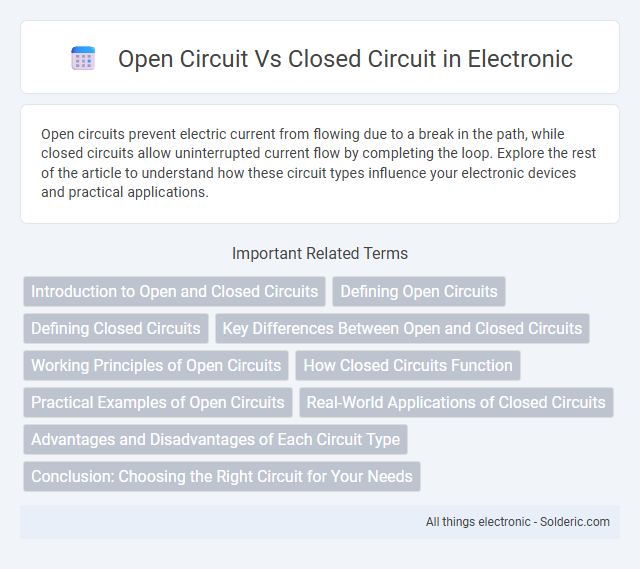Open circuits prevent electric current from flowing due to a break in the path, while closed circuits allow uninterrupted current flow by completing the loop. Explore the rest of the article to understand how these circuit types influence your electronic devices and practical applications.
Comparison Table
| Aspect | Open Circuit | Closed Circuit |
|---|---|---|
| Definition | Electrical circuit with a break, no current flow | Complete electrical circuit with continuous current flow |
| Current Flow | No current | Current flows |
| Functionality | Inactive or off state | Active or operational state |
| Resistance | Infinite or very high resistance | Low resistance path |
| Voltage | Voltage present across the gap | Voltage drops across components |
| Use Cases | Fault detection, switch off state | Power delivery, device operation |
| Example | Disconnected wire | Light bulb circuit |
Introduction to Open and Closed Circuits
Open circuits feature a break or gap preventing current flow, causing electrical devices to remain inactive due to the absence of a complete path. Closed circuits establish a continuous loop, enabling current to flow unimpeded through components, essential for powering devices and systems. Understanding the fundamental difference between open and closed circuits is crucial for designing and troubleshooting electrical and electronic systems.
Defining Open Circuits
An open circuit occurs when there is a break in the electrical path, preventing current flow and causing the circuit to be incomplete. This interruption can be due to a disconnected wire, a switched-off component, or a fault in the circuit itself. Open circuits are characterized by infinite resistance and zero current, contrasting with closed circuits where the electrical path is continuous and current flows freely.
Defining Closed Circuits
Closed circuits refer to electrical pathways where the current flows uninterrupted from the power source, through the load, and back to the source, creating a complete loop. This continuous flow allows devices to operate efficiently by maintaining consistent voltage and current levels. Understanding closed circuits helps you ensure proper functionality and safety in electrical systems by preventing open circuit interruptions.
Key Differences Between Open and Closed Circuits
Open circuits have a break or gap that prevents current from flowing, resulting in no electrical connection and interrupted operation. Closed circuits form a complete and continuous path for current, enabling devices to function properly by allowing electrical energy to flow uninterrupted. Understanding the key difference helps you troubleshoot and design efficient electrical systems by ensuring the circuit's continuity is maintained.
Working Principles of Open Circuits
Open circuits operate on the principle that the electrical path is incomplete, preventing current flow due to a break or gap in the circuit. This interruption causes voltage to appear across the open terminals while no current passes through the load. Understanding the behavior of open circuits is crucial for diagnosing circuit faults and ensuring proper electrical system function.
How Closed Circuits Function
Closed circuits function by creating a complete, uninterrupted path for electric current to flow from the power source through the load and back to the source, enabling energy transfer and device operation. The continuous loop ensures that electrons move freely, powering components such as lights, motors, or sensors. Any break or gap in this circuit interrupts the current flow, causing the device to stop functioning.
Practical Examples of Open Circuits
Open circuits occur in everyday devices like broken phone chargers or disconnected light bulbs, where the electrical path is interrupted, preventing current flow. In household wiring, a blown fuse or tripped circuit breaker creates an open circuit to halt electricity and protect against hazards. Faulty switches in appliances also act as open circuits, stopping power until repaired or reset.
Real-World Applications of Closed Circuits
Closed circuits are essential in powering everyday electronic devices such as smartphones, computers, and household appliances, ensuring a continuous flow of electric current for proper functionality. In automotive systems, closed circuits enable efficient operation of components like headlights, ignition, and sensors by maintaining unbroken electrical pathways. Industrial machinery relies on closed circuits to control motors and automation processes, enhancing reliability and safety in production environments.
Advantages and Disadvantages of Each Circuit Type
Open circuits prevent current flow, enhancing safety by reducing the risk of short circuits but causing devices to remain non-functional due to interrupted pathways. Closed circuits enable continuous current flow, ensuring efficient device operation and reliable power delivery, but they pose risks such as overheating and potential electrical hazards if not properly managed. Understanding these trade-offs is crucial for designing electrical systems tailored to specific safety and performance requirements.
Conclusion: Choosing the Right Circuit for Your Needs
Open circuits halt current flow due to a break, making them ideal for safety mechanisms and diagnostic testing, while closed circuits maintain continuous current, essential for powering devices efficiently. Your choice depends on application requirements: open circuits provide control and safety, whereas closed circuits ensure consistent operation. Evaluating factors like functionality, safety, and energy efficiency helps determine the best circuit type for your specific needs.
open circuit vs closed circuit Infographic

 solderic.com
solderic.com